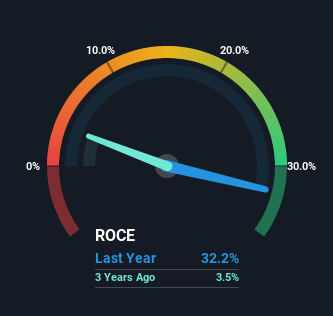Finding a business that has the potential to grow substantially is not easy, but it is possible if we look at a few key financial metrics. Amongst other things, we'll want to see two things; firstly, a growing return on capital employed (ROCE) and secondly, an expansion in the company's amount of capital employed. Put simply, these types of businesses are compounding machines, meaning they are continually reinvesting their earnings at ever-higher rates of return. So when we looked at the ROCE trend of Samudera Shipping Line (SGX:S56) we really liked what we saw.
Understanding Return On Capital Employed (ROCE)
For those that aren't sure what ROCE is, it measures the amount of pre-tax profits a company can generate from the capital employed in its business. To calculate this metric for Samudera Shipping Line, this is the formula:
Return on Capital Employed = Earnings Before Interest and Tax (EBIT) ÷ (Total Assets - Current Liabilities)
0.32 = US$133m ÷ (US$571m - US$160m) (Based on the trailing twelve months to December 2021).
So, Samudera Shipping Line has an ROCE of 32%. That's a fantastic return and not only that, it outpaces the average of 9.2% earned by companies in a similar industry.
See our latest analysis for Samudera Shipping Line

Historical performance is a great place to start when researching a stock so above you can see the gauge for Samudera Shipping Line's ROCE against it's prior returns. If you're interested in investigating Samudera Shipping Line's past further, check out this free graph of past earnings, revenue and cash flow.
The Trend Of ROCE
Investors would be pleased with what's happening at Samudera Shipping Line. The data shows that returns on capital have increased substantially over the last five years to 32%. The amount of capital employed has increased too, by 33%. So we're very much inspired by what we're seeing at Samudera Shipping Line thanks to its ability to profitably reinvest capital.
On a side note, we noticed that the improvement in ROCE appears to be partly fueled by an increase in current liabilities. The current liabilities has increased to 28% of total assets, so the business is now more funded by the likes of its suppliers or short-term creditors. It's worth keeping an eye on this because as the percentage of current liabilities to total assets increases, some aspects of risk also increase.
The Bottom Line
To sum it up, Samudera Shipping Line has proven it can reinvest in the business and generate higher returns on that capital employed, which is terrific. And with the stock having performed exceptionally well over the last five years, these patterns are being accounted for by investors. Therefore, we think it would be worth your time to check if these trends are going to continue.
Like most companies, Samudera Shipping Line does come with some risks, and we've found 2 warning signs that you should be aware of.
If you want to search for more stocks that have been earning high returns, check out this free list of stocks with solid balance sheets that are also earning high returns on equity.
New: Manage All Your Stock Portfolios in One Place
We've created the ultimate portfolio companion for stock investors, and it's free.
• Connect an unlimited number of Portfolios and see your total in one currency
• Be alerted to new Warning Signs or Risks via email or mobile
• Track the Fair Value of your stocks
Have feedback on this article? Concerned about the content? Get in touch with us directly. Alternatively, email editorial-team (at) simplywallst.com.
This article by Simply Wall St is general in nature. We provide commentary based on historical data and analyst forecasts only using an unbiased methodology and our articles are not intended to be financial advice. It does not constitute a recommendation to buy or sell any stock, and does not take account of your objectives, or your financial situation. We aim to bring you long-term focused analysis driven by fundamental data. Note that our analysis may not factor in the latest price-sensitive company announcements or qualitative material. Simply Wall St has no position in any stocks mentioned.
About SGX:S56
Samudera Shipping Line
Engages in the transportation of containerized and non-containerized cargo to various ports in Southeast Asia, the Indian Sub-continent, the Far East, and the Middle East, and internationally.
Solid track record with excellent balance sheet and pays a dividend.
Market Insights
Community Narratives



